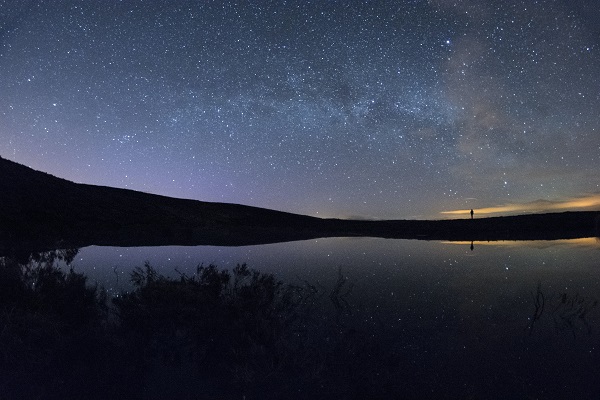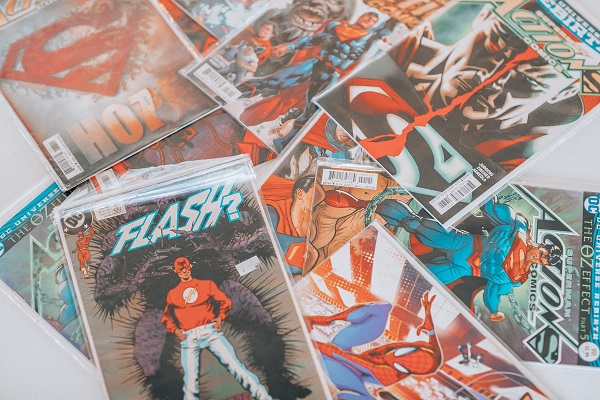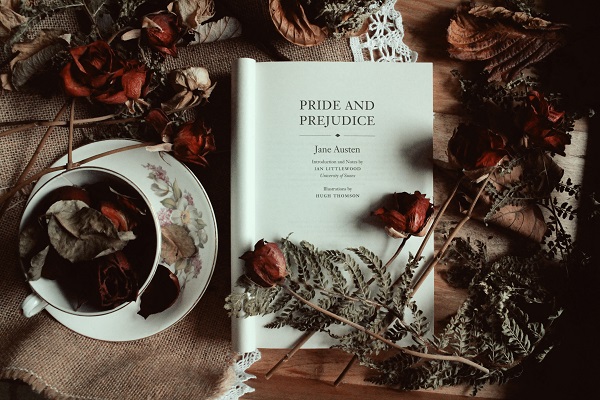In almost any story, the hero will fit into an archetype in some way or another.
Using character archetypes doesn’t mean the story isn’t creative, though! Archetypes are simply tools for writers to use and play with.
A story outline (like the three-act structure, for example) can be a good scaffolding for us build our story around. A character outline can be a good scaffolding for us to build a hero around.
As readers, we can train ourselves to spot these archetypes. As writers, we can utilise established archetypes to give a character more depth. Analysing archetypes is a great activity for a writer to do.
We can consider archetypes when trying to understand more about the heroes we’ve already written. We can use them when planning a story to create the best character for the narrative and the world.
Whatever the stage of your writing, knowing the different types of literary heroes can help you write better protagonists. Let’s dive in and take a look at nine common examples.
Hero type #1: Epic hero
What is an epic hero?
The epic hero is the first archetype that comes to mind when we think of heroes. They are called to adventure, they face trials, they save the day.
They will begin their story at a point of stability and they will usually return to stability, only now they have been changed in some way.
For some, this means they have gained power(s) through their journey. For others, it means they now know more about the world at large.
What are some examples of epic heroes?
Epic heroes are classic heroes, and it doesn’t get more classic than Odysseus from Homer’s Odyssey.
Odysseus is challenged to complete trials; he shows courage, loyalty and smarts. Eventually he succeeds in his quest and returns to a period of stasis.
A more recent example of an epic hero could be Aragorn from The Lord of the Rings.
Aragorn was born noble, but at the beginning of the story he is in a humble state. Then he is challenged, and eventually becomes the king his people need him to be.
To go even more recent, we can consider Rapunzel from Tangled. Rapunzel begins her story at a point of stasis, but finds adventure when she becomes bored of her limited life.
She is keen to explore, which she does, facing trials along the way. Finally she ends the story as the returned princess.
How to write an epic hero
While many epic heroes are admirable or at least interesting characters, that’s not their primary function.
An epic hero doesn’t have to have as much depth and inner turmoil as some other types of literary heroes. Writing an epic hero can be more straightforward.
An epic hero will often be destined for greatness of some kind. That could mean they’re the long-lost child of royalty or even gods.
Once you have your epic hero’s backstory, you can put them on the traditional heroic path, like Campbell’s Hero’s Journey, and they will complete their quest, save the day and return to a point of stability.
If they were long-lost royalty, their new stability could be happily ruling their kingdom. Maybe they return to the exact same point they started from, happy with their original, humble life.
However they finish their quest, the final point in writing an epic hero is giving them their (happily) ever after.

Hero type #2: Iconic hero
What is an iconic hero?
The iconic hero is often bundled in with the epic hero, but they aren’t quite the same.
Both the iconic and the epic hero are classically heroic. They are courageous, loyal and clever.
The difference is that the epic hero goes through a journey and comes out the other end changed in some way. The iconic hero is eternal and does not change.
It can be easy to think that this type of literary hero isn’t interesting, but that isn’t true. As readers, we like these characters. They can feel familiar and even safe. We know that they won’t change.
An iconic hero won’t die in their own story. The story’s other characters could change, die or simply leave, but the iconic hero is always what we expect and need them to be.
What are some examples of an iconic hero?
Literature is littered with iconic heroes. They’re especially popular in comic books.
Consider Batman, Superman, Hulk, Wolverine, Professor X, Captain America. These characters are defined by their respective traits. They may experience a character arc, but Batman is always Batman.
The comic book iconic hero works well because readers often jump into comics at random, not always starting with the very first issue.
The iconic hero archetype means we know what to expect when we pick up the next Batman comic, even if we’ve missed the last 100 or so.
This is also why writers can reboot these stories and franchises so frequently.
The iconic hero is also popular among detective characters. Agatha Christie’s Poirot, Sherlock Holmes, and even Nancy Drew are all iconic heroes.
They hunger for truth, and they come out the other end the same way they went in. James Bond and even Geralt from the Witcher series fit this character type as well.
How to write an iconic hero
Looking at the above examples, there’s something that links these heroes: they’re all stars of multi-volume series.
To write an iconic hero, your character must appear in many stories. Otherwise, they’re just a regular old hero, not an iconic one.
Start by getting to know your character. Understand them as best you can, because they aren’t changing.
You might feel that you need to change them to progress the story along. For example, the detective getting better at detecting in order to solve the crime.
But the detective doesn’t really need to get any smarter; they just find the next clue.
You can change the environment around your hero, however. You can have some fun with an established iconic hero by putting them in a new and foreign situation and exploring what they do.
How does Batman react when he’s suddenly forced to live in a submarine? (He probably just broods.)

Hero type #3: Anti-hero
What is an anti-hero?
The anti-hero has become increasingly popular over the past decade. The key feature of an anti-hero is their lack of typical heroic attributes.
While a typical hero is courageous and idealistic, and follows a moral code, an anti-hero does none of these things.
Anti-heroes may perform actions that are morally ‘correct’ according to the laws of their universe, but they don’t perform these actions for moral reasons. Often, they act for selfish reasons.
Anti-heroes do what needs to be done and don’t particularly care who they hurt along the way.
What are some examples of anti-heroes?
For a lot of people, the first anti-hero that comes to mind is everyone’s favourite science teacher, Walter White from Breaking Bad.
Walter White is the hero of the story. He takes to a life of crime to save his family from financial ruin. But as he continues on his path, he makes more and more questionable decisions.
His antagonists are undoubtedly villains, but he is by no means a good guy.
For another example, we can look at the early version of Han Solo from the Star Wars franchise.
Hardcore fans will always tell you that ‘Han shot first’, referencing a gun fight in the 1977 film, where Han shot Greedo first. In re-releases, this was edited so that Greedo shot first and Han simply retaliated.
Why is the distinction so important? If Han shot first, it’s an example of his moral ambiguity. He shoots first, asks questions later (or never).
We later see Han become more of a typical hero, where he makes moral and just choices, but throughout the first Star Wars film, he is only motivated by his own interests: he wants to get paid for his work.
He is a hero by his actions, but an anti-hero by his justifications.
How to write an anti-hero
Writing an anti-hero can mean writing a heroic path for your character to follow, and then writing a character who is not at all interested in that path.
They’ll go along for the ride if it benefits them, but they aren’t interested in acting without (mostly material) reward.
An anti-hero isn’t a reluctant hero (we’ll come to that archetype soon); they’re just someone who will only perform heroic deeds if they are benefited by those deeds (or who achieves good outcomes through not-so-good means).
Hero type #4: Reluctant hero
What is a reluctant hero?
A reluctant hero has a lot of similarities to an anti-hero. Neither of them really want to be there; they’re just forced to be there.
However, while the anti-hero is there because of personal gain, the reluctant hero is forced to be there because to do anything else would go against their moral compass.
What are some examples of a reluctant hero?
There’s no better example of a reluctant hero than Shrek. He grows and shows his vulnerability and eventually makes heroic choices that don’t directly benefit him.
Throughout the original Shrek film, we are shown that he is rude because he is insecure, and expects people to leave him. Once he lets people into his life, he is loyal to them.
He saves Donkey from assumed death at the dragon’s tower because it’s the right thing to do. Leaving Donkey to die would distract the dragon, which would benefit Shrek.
He makes personal sacrifices to do what’s right, even though he doesn’t want to.
Another great reluctant hero is John McClane from Die Hard. He just wants to go on a holiday, but he’s stuck in a building filled with terrorists.
He’s a hero because his conscience tells him that he has to do something about that, even if he’d really rather not.
How to write a reluctant hero
Writing a reluctant hero is similar to writing an anti-hero. You create a heroic path for your character, and then a character who does not want to travel that path.
A reluctant hero can require a bit more character development than an anti-hero and often some backstory to go with it.
They have to have inner turmoil. They don’t want to do this, but because of who they are as a person, they are compelled to. Reluctant heroes can be very dynamic and engaging to read and write.

Hero type #5: Liminal hero
What is a liminal hero?
A liminal hero is a hero who is in between states or spaces. They might cross over with some other types of heroes, but this type of hero has some unique characteristics.
‘Liminal’ indicates a space, a state, a feeling that’s between two established elements.
Being a teenager is existing in a liminal state. A teenager isn’t quite a child, but they’re also not an adult yet either. Because of this, a lot of YA stories feature liminal heroes.
You don’t have to write YA to write liminal heroes, though, because teenagehood isn’t the only liminal state available to you.
A ghost is in a liminal state. They’re dead, but they’re still on this plane of existence.
A liminal hero is a hero going through their own form of change and transition. This affects their story, their interactions with others, and their character arc.
What are some examples of liminal heroes?
Many liminal characters exist in the YA space because their transition to adulthood and their transition through another liminal space can reflect each other.
Stephenie Meyer’s Twilight is such a great example of a liminal hero, she even named the book to reflect that state – twilight is a transition between day and night.
Meanwhile, Bella (our liminal hero) is in her own transition period. Bella is a teenager, transitioning into adulthood. Later she’s a human, transitioning into a vampire.
It’s not until the end of the saga that the transitions are completed and the liminal hero’s story is over.
Another great liminal hero is Spiderman. Peter Parker/Miles Morales/your preferred Spiderman is another teen trying to become a mature adult. In the midst of that, he has to be a superhero.
He can never be 100% himself (a teenager) or 100% Spiderman (a superhero); he always exists somewhere between those states.
Zoraida Córdova’s Labyrinth Lost (the first in the Brooklyn Brujas series) sees the hero, Alex, in a liminal space: the space between life and death.
Alex doesn’t fit in with her family, and she’s a bruja with magic, but she hates magic. She goes on an adventure to save her family after she made a terrible, magic-based mistake.
Alex remains in a state of flux for her entire story and only exits her liminal space when her journey is completed.
Remember, though: just because liminal characters often exist in YA literature, that doesn’t limit you as a writer. You can write whatever you want. (You’re in your own liminal space.)
How to write a liminal hero
Liminal heroes are inherently uncertain. They don’t really know what they want yet. They’re in-between.
For some, this means being in a literal liminal space (like life vs. death or normal vs. superhero). For others, it can simply be a transition time in their life.
Liminal characters exist between the spaces of certainty. But uncertainty is a character trait as well. If you’re not sure where to begin writing a liminal hero, remember how you felt in key transition times of your life.
Ever-changing characters are dynamic and engaging. That’s why we love liminal heroes (and part of why YA literature is so popular).

Hero type #6: Everyman hero
What is an everyman hero?
The everyman hero is an ordinary person, with no special abilities, who acts heroically. They’re not Superman; they’re just the person who’s here.
The everyman hero is almost an audience insert. The archetype is designed to represent the average person.
It can be hard to empathise with a superpowered hero of the story, but easy to connect to a regular person – an everyman.
The name ‘everyman’ is gendered, but this heroic archetype isn’t limited to men. Any character can represent the average person and complete heroic tasks.
Even characters made of plastic… (See below.)
What are some examples of an everyman hero?
One of the best examples of an everyman hero is in The Lego Movie. The hero of the story, Emmet, is nothing special. In fact, the film directly tells us that he is ordinary.
Emmet still acts heroically and saves the day, despite not being ‘special’.
Ellen Ripley from Alien is also an everyman hero. Ripley possesses no ‘special’ abilities besides her determination, and she still manages to overcome the Xenomorph and survive.
And who could forget Frodo Baggins and Samwise Gamgee? These two heroes are just regular hobbits who find themselves on an epic quest to save the world.
Their compassion for others and determination allow these ‘everyhobbit’ heroes to complete their monumental task.
How to write an everyman hero
The everyman hero is a normal person, who finds themselves in abnormal circumstances. They face extraordinary challenges.
They may think themselves to be special in some way (the way that Emmet does), but the power of this archetype is that they are just like us.
To write an everyman hero, you need to write a character who cares and who will do the right thing.
If anything makes this type of character special, it’s their compassion, determination and willingness to sacrifice for others.
Hero type #7: Romantic hero
What is a Romantic hero?
The name ‘Romantic hero’ doesn’t refer to a hero who has romantic relationships. Instead it refers to the Romantic period of literature.
The defining features of a Romantic hero are their constant rejection of established norms and their sense of self-importance. They reject authority and rules and are often introverted and isolated.
It’s important to note that while these concepts may have negative connotations, they are not necessarily character flaws in a Romantic hero.
The heroic archetype of ‘misfit hero’ is a modern example of a Romantic hero.
What are some examples of Romantic heroes?
A hero who doesn’t conform to societal expectations and is self-important and moody? There’s no better example than Mr Darcy from Pride and Prejudice.
Darcy doesn’t act how we (and how Elizabeth) expect someone in his position to act. In the beginning, at least, he’s somewhat rude and doesn’t particularly care what other people think of him.
This is in direct opposition to a lot of the other characters who are caught up in the many rules of Regency society.
Katniss Everdeen from The Hunger Games series can also be seen as a Romantic hero. Katniss doesn’t follow the rules of society, and she is better for that.
She tends to isolate or distance herself, but she thinks outside the box because of her isolation, and can succeed in her many trials because of her unique way of seeing the world.
How to write a Romantic hero
The way to write a Romantic hero is to give them lots of inner turmoil, broody behaviour and (occasionally unearned) confidence.
Romantic heroes know that they do not fit in, and they do not care. To write a Romantic hero (or Byronic hero – see below), you need to know what established norms they will reject.
And, importantly, you need to know why those rejections make them interesting and heroic.
Katniss is heroic because her rejection of her society means she is able to (spoiler!) lead a rebellion. Darcy’s rejection means he is able to (spoiler?) stand out as a romantic partner to Elizabeth.

Hero type #8: Byronic hero
What is a Byronic hero?
Lord Byron, never satisfied with established archetypes, invented a twist on the Romantic hero: the Byronic hero.
The Byronic hero is a sub-category of the Romantic hero. The key difference between them is that while Romantic heroes are better off because of their rejection of societal rules, the Byronic hero has been hurt and rejected by society.
In their isolation, they become apathetic or even dangerous to themselves and to others.
What are some examples of a Byronic hero?
The best example of a Byronic hero is Lord Byron himself. He was overly obsessed with himself and his own work and everywhere he went, he left a trail of broken hearts in his wake.
We can also see this archetype in Bojack (Bojack Horseman), Loki (the Marvel Cinematic Universe), Mr Rochester (Jane Eyre) and Heathcliff (Wuthering Heights).
How to write a Byronic hero
Writing a Byronic hero is similar to writing a Romantic hero. They both live with inner turmoil, and as the writer, you’ll spend a lot of time in your character’s head.
To write a Byronic hero, you first need to know why they were rejected from society. What crime, sin or difference set them apart from their peers?
Once your hero has settled down, isolated from society, how will they twist and change into someone who wilfully eschews tradition?
You also need to know if your hero would return to society, if society would have them. For some Byronic heroes, returning to the group that rejected them is their ultimate goal.
Finally, you need to decide if your Byronic hero will change their behaviour and stop being a danger to themselves and others. Or will they embrace their fatal flaw, their story resulting in tragedy?
Hero type #9: Tragic hero
What is a tragic hero?
The tragic hero was first defined by Aristotle, and they are the central player in most tragic stories.
Aristotle argued that any good tragic story needed emotional investment from the audience. We need to be sympathetic to the hero and feel catharsis at the end of their story (which was most commonly their defeat in some way).
A tragic hero is someone who is flawed in a major way and though doing their best, they still meet tragedy at the end of the story.
They may make poor decisions or do bad things. But at their heart, they are (or at least want to be) good. That’s why their downfall is so tragic.
What are some examples of tragic heroes?
Can you get any more tragic than Romeo and Juliet? Romeo is passionate, excited, in love. He would do anything for his love. He’s reckless, but that’s because he’s so passionate.
His recklessness is also what leads to his and his lover’s deaths. If not for that trait, both he and Juliet may have avoided death.
To switch to a contemporary example, what about Game of Thrones? (Spoilers for the last season of GoT. Scroll past the paragraphs between the stars to avoid.)
*
*
*
We watched Daenerys Targaryen survive many hardships throughout the run of GoT, only to see her end turn tragic.
Dany’s whole journey was to become the ruler of the seven kingdoms. Her single-minded desire for the Iron Throne became her fatal flaw, and she ultimately died because of her actions.
Ned Stark also suffered a tragic fate where his downfall was his own moral code.
(He is perhaps an even better example of a tragic hero than Daenerys, who could arguably have been called a ‘villain’ rather than a hero in the end.)
*
*
*
Jay Gatsby from The Great Gatsby is another tragic hero. Throughout the novel, we seem him constantly searching for more. For the American dream. For Daisy. For a sense of satisfaction that he will never find.
Gatsby is near-delusional, obsessed with the dream of the perfect life with the perfect wife. Because of his inability to accept the truth of life, to see beyond his idealism, he meets his tragic end.
How to write a tragic hero
Writing a tragic hero is hard! They have to be flawed and meet their tragic downfall because of those flaws. But at the same time, the audience has to care about them.
Keep in mind that a tragic hero must be virtuous as well as flawed, suffer a reversal of fortune, have the sympathy of the audience and (despite their best efforts or intentions) cause harm or come to ruin.
Should be simple, right?
Aristotle broke it down a bit for us:
- Hamartia is the hero’s tragic flaw that leads to their downfall.
- Hubris is the hero’s excessive or unreasonable pride.
- Peripeteia is the sudden change or reversal of fortune.
- Anagnorisis means ‘recognition’ and is where the hero learns something important about themselves or the world.
- Nemesis is the unavoidable punishment for the hero.
- Catharsis is the hero’s inevitable downfall and where the audience can release their built-up emotions. It may also bring renewal or some positive change to the hero’s world.
This iconic structure is still present in today’s fiction, though many authors manage to create a tragic hero without all these elements. (Nemesis, for example, is often omitted in contemporary stories.)
These moments in a tragic hero’s story can help us plot out an emotionally moving narrative and character.

Bonus: Combination heroes
Above are the key archetypes of literary heroes, but don’t feel limited to using just one type. And if you’ve already started writing a character, but they don’t neatly fit into one of these types, that’s fine.
Some of the most engaging characters are those that are a combination of different archetypes.
The reluctant everyman hero. The liminal Romantic hero. The iconic anti-hero. Or any other combination that suits your writing style and your story.
As a reader, you might not be able to categorise each hero you read as one of these archetypes. However, each hero will partially fit into at least one archetype.
Let these types of literary heroes inspire your writing. Maybe you’ll be the first to use a new archetype combination in your story.